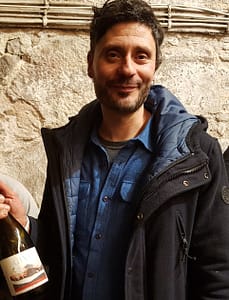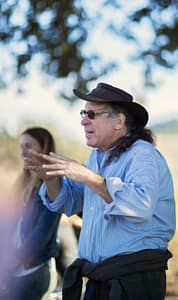Folias de Baco was one of the greatest revelations at the Simplesmente Vinho fair. It started at the dinner in Porto’s Typographia Progresso restaurant, where we were served the Uivo Pet Nat 2017, a joyful start of an inspiring evening.
The word folia evokes something merry and bright, joyful, and capricious maybe. And this can be a first impression of Tiago Sampaio’s wines. But behind this is yearlong studies and hard work.
Tiago Sampaio with the Uivo Renegado
He is based in Alijó in the sub-region of Cima Corgo. This has traditionally been a stronghold for Moscatel wines in the Douro, and his parents delivered to the famous coop in Favaios, maybe the leading producer of wines of that kind in the past. Here Tiago mixes tradition with new ideas and what he learned in his studies. As an example, his love for pinot noir derives from his studies in Oregon.
His Uivo range was created in 2016. With these limited editions he wants to explore alternative vinification techniques, discover the potential of varieties, but never forgetting tradition. The Uivo Renegado Vinhas Velhas 2017 is a field blend of both red and white grapes (around 50/50%). This, and because of the turbidity, makes it impossible for him to bottle it under DOC. It’s made with whole clusters, foot-trodden and with four days of skin-contact.
Uivo Renegado Vinhas Velhas 2017 (Tiago Sampaio, Folias de Baco)
Light red, cloudy. Strawberry, raspberry, some vegetal/herbal elements. Smooth and glyceric, but with some structure and with a hint of grapefruity bitterness in the end.
Price: Medium
Food: Tasty fish and shellfish, and I would believe perfect for a smorgasbord (smörgåsbord in Swedish)
Leave a Comment


















